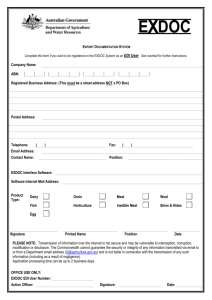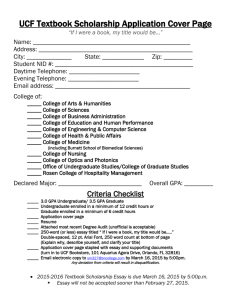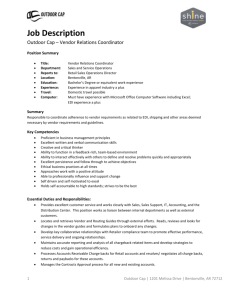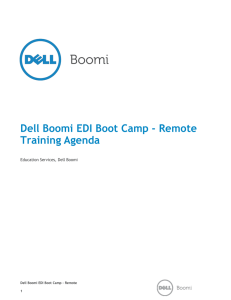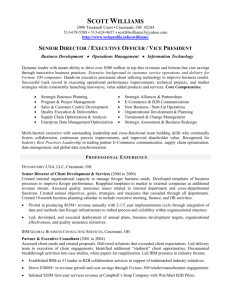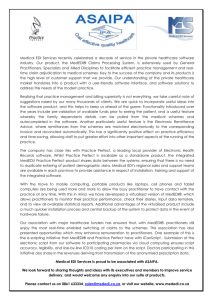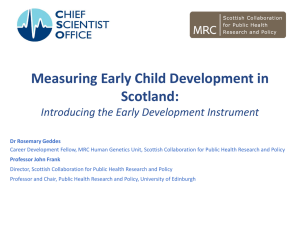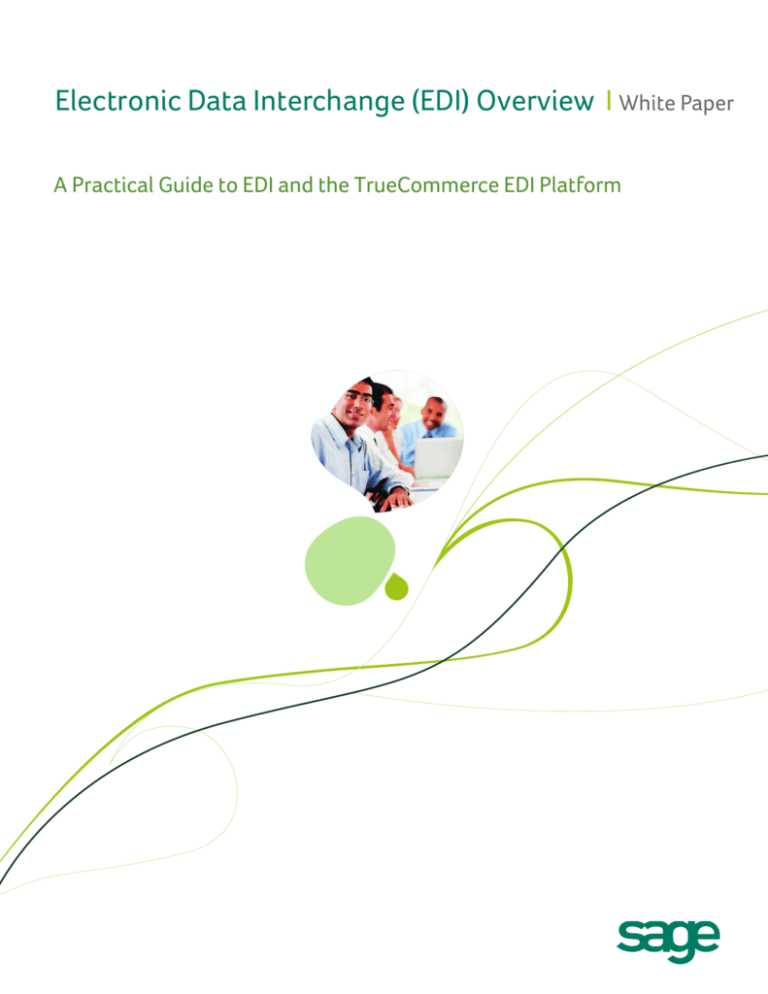
Electronic Data Interchange (EDI) Overview I White Paper
A Practical Guide to EDI and the TrueCommerce EDI Platform
EDI Overview
Table of Contents
Introduction.............................................................................................................3
What is EDI?............................................................................................................3
EDI Defined.......................................................................................................3
The Problem Addressed by EDI........................................................................3
The Benefits of Using EDI.................................................................................4
The History of EDI.............................................................................................4
ANSI ASC X12 Standards.................................................................................5
The EDI Message Dissected.............................................................................5
Examples of commonly used EDI transaction sets............................................5
4 Key Components to EDI................................................................................7
How does the TrueCommerce EDI Platform work?.............................................7
Typical Transaction Flow........................................................................................8
A Practical Guide to EDI and the TrueCommerce EDI Platform
2
EDI Overview
Introduction
The purpose of this paper is to provide an overview of EDI – or Electronic Data Interchange. It explains the
technology, the benefits and how the TrueCommerce EDI Platform gives you an end-to-end solution which
provides all four components of EDI.
What is EDI?
EDI Defined
Electronic Data Interchange (EDI) is a set of standards that collectively provide a common protocol or
syntax for transacting business documents electronically. In essence, EDI is to electronic commerce as
grammar is to verbal communication – it is a set of rules and guidelines that are applied when developing
and implementing software and services designed to transmit business documents electronically. Just as a
group of individuals with diverse backgrounds can use a common language (such as English) to converse
with each other, EDI provides a common “language” that enables businesses with dissimilar computerbased business systems to communicate with each other.
Although by pure definition EDI is a standard, in many respects this description is a contradiction to the
reality of EDI. There are myriad variations and versions of EDI standards in use today. In this regard EDI is
much like the English language with its many regional dialects and colloquialisms. The federal government
and numerous trade associations have developed EDI standards for specific vertical markets, and large
companies typically have additional requirements that uniquely govern how EDI standards are explicitly
applied to their electronic transactions.
The Problem Addressed by EDI
Without the use of EDI or some other form of electronic commerce, companies must use a paper-based
system for transacting business – meaning paper documents are mailed or faxed between companies
to exchange information. In this scenario, a company typically enters data into a PC- based business
application (ex. accounting software), prints a form containing the data (such as a purchase order or an
invoice), and mails or faxes this document to a trading partner (customer or vendor). The trading partner,
after receiving the document containing the data, must then re-key the data into their PC-based business
application. Inherent in this process is the inefficiency associated with waiting for large volumes of business
data to be transferred, processed and verified, and the potential for errors as the information is manually
transcribed.
The costs associated with data entry errors include:
• lost revenue due to incorrect billing
• chargebacks assessed by trading partners
• added expenditures required to correct mistakes
• delays in orders being processed
• damage to reputation/client relations
A Practical Guide to EDI and the TrueCommerce EDI Platform
3
EDI Overview
The Benefits of Using EDI
Companies that are EDI enabled can send and receive business documents electronically with their trading
partners. In simple terms, EDI enables the computer system of one company to “talk” to the computer
system of another company and digitally exchange data. Because this digital exchange of data is facilitated
using computers, most if not all of the associated business processes (such as data population and
verification) can be automated so that they occur with little or no manual intervention. As such, key benefits
include the reduction or elimination of data entry errors and transaction processing that is more expeditious
and streamlined.
Ultimately, using EDI can save a business time and money when sending and receiving vital business
documents. As an example, it is not uncommon for vendors who supply goods and services to large
organizations to receive payments for invoices sent via EDI as much as 30 days sooner than those sent
via fax, simply because EDI transactions are processed by their customers more quickly and efficiently.
Receiving payments sooner can deliver real-world savings by improving cash flow and mitigating the need
to borrow money. Other savings are realized through the reduction or elimination of costly data entry errors.
History of EDI
EDI has been under development in the U.S. in one form or another since the mid-1960s. In 1968, a
group of railroad companies concerned with the quality of inter-company exchanges of transportation
data formed an organization to study the problem and to do something to improve it. This organization
was the Transportation Data Coordinating Committee (TDCC).
At about the same time, individual companies such as General Motors, Super Valu, Sears and K-Mart
were also addressing the inefficiencies of inter-corporate document movement by using their own
electronic (but proprietary) systems with their major trading partners.
The problem lay in the fact that each system was specific to that company with no standard except in a
proprietary sense. A hypothetical company in the late 1960s doing business with GM, Sears and K-Mart
therefore needed three different systems interfaces.
Several industries in the early 1970s sponsored a shared EDI system and usually turned it over to a
third party network. In some cases, the shared system was developed by the third party for a group of
common companies or industry trade group. Examples of this early sharing include IBM IVANS, which
the U.S. property and casualty insurance industry sponsored. Another was ORDERNET, sponsored by
the pharmaceutical industry.
These industry trade group systems had the same disadvantage as the company proprietary EDI system:
they were standard, but limited in scope, unable to communicate with other trade group EDI systems.
(ORDERNET, for example could not communicate with the transportation carriers’ EDI system.)
In 1973, the TDCC decided to develop a set of standards for EDI between companies and to invent a
so-called “living standard” -- a standard that included standards on how to change the standards! This
“EDI enables the computer
resulted in the first inter-industry EDI standard in 1975 covering air, motor, ocean, rail and some banking
system of one company to
applications.
“talk” to the computer system
What evolved now includes the ANSI X12 standards first published in 1981 for general business use, the
of another company and
WINS standards for the warehouse industry; the UCS standards for the food and drug industry; HIPAA
digitally exchange data.”
standards for the healthcare industry and TDCC standards for the transportation industry. European
development of TRADACOMS, ODETTE and JEDI started around 1984.
A Practical Guide to EDI and the TrueCommerce EDI Platform
4
EDI Overview
In 1985, work started on EDIFACT (EDI For Administration, Commerce & Transportation), an international
standard through the auspices of the United Nations.
ANSI ASC X12 Standards
The most common EDI standard in use in the United States is known as ANSI ASC X12, or simply as X12.
ANSI is an abbreviation for the American National Standards Institute. The institute has been coordinating
standards in the United States since 1918 and maintains a number of voluntary committees including the
ANSI Accredited Standards Committee X12. This committee is comprised of members from both the private
and public sectors representing a broad range of industries. Subcommittees, using a consensus process,
propose new standards or modifications to existing standards.
EDI Message Dissected
An EDI message contains a string of data elements, each of which represents a singular fact, such as a
price, product model number, and so forth, separated by a delimiter. A delimiter is a character that identifies
the beginning or the end of a character string (a contiguous sequence of characters). The delimiting
character is not part of the character string. In EDI transactions, asterisks (*) are commonly used as
delimiters.
The entire string is called a data segment.
One or more data segments framed by a header and trailer form a
transaction set, which is the EDI unit of transmission (equivalent to a
message). A transaction set often consists of what would usually be
contained in a typical business document or form, such as an invoice
or purchase order.
Each transaction set or document has a specific X12 identification
code. Some of the more popular ones are explained below. A full
listing is included on our website.
Examples of commonly used EDI transaction sets
X12ID Code
Transaction Set
Document Usage
850
Purchase Order (PO)
A trading partners sends a PO to order products from a vendor
810
Invoice
The vendor sends an invoice back to their trading partner as a bill
for the products ordered
997
Acknowledgement
An acknowledgement is sent as a receipt to the sender upon the
retrieval of a document
856
Advanced Ship Notice
(ASN)
The vendor sends an ASN to their trading partner specifying
to a mutually agreed level of detail the dates and contents of a
shipment. Many businesses require the receipt of an ASN from a
supplier before the shipment reaches their receiving docks.
820
Remittance Advice
Remittance advice informs the vendor that their trading partner
has made a deposit into their bank account.
852
Product Activity Data
The Product Activity Data is used by trading partners to advise
vendors of inventory, sales and other product activity information
To find out more about EDI transaction codes, please visit our website at
www.highjump.com/truecommerce
A Practical Guide to EDI and the TrueCommerce EDI Platform
5
EDI Overview
All transaction sets begin with the Transaction Set Header (ST) segment and end with the Transaction Set
Trailer (SE) segment, and typically other specific types of segments are required to be used in a particular
sequence within a transaction set. As an example, the following shows some of the segments that may be
used within a purchase order and the required sequence in which they must appear:
ID Title
ST Transaction Set Header
BEG Beginning Segment for Purchase Order
CUR Currency
REF Reference Identification
PER Administrative Communications Contract
TAX Tax Reference
FOB F.O.B. Related Information
CTP Pricing Information
PAM Period Amount
CSH Sales Requirements
TC2 Commodity
Many transaction sets have a unique beginning segment that immediately follows the ST segment, such as
the 850 BEG Segment used for purchase orders or the 856 BSN Segment used for advance ship notices.
The ANSI ASC X12 standard designates every available segment as either “mandatory,” “optional” or
“conditional,” and in some instances there are limits as to the number of times a particular segment may be
repeated at its location within a transaction set.
A loop refers to when a group of segments (two or more segments) are repeated in a transaction set, such
as a Purchase Order requesting multiple items. A nested loop refers to when a loop exists within another
loop, such as when multiple allowances are applied to an item being ordered along with other items.
Once generated, transaction sets are transmitted using an electronic envelope as defined by the ANSI ASC
X12 Standard. For every message there are three levels of enveloping:
1.
The innermost level is the transaction set, which can be
identified by the ST/SE segments.
2.
The middle level, defined by GS/GE segments, is the
Functional Group envelope and is used to group similar
types of transaction sets (such as Purchase Orders
and Purchase Order Acknowledgements) within a
transmission.
3.
The outermost level is the interchange envelope that
is defined by ISA and IEA segments. The interchange
envelope encloses the data from sender to one receiver.
A Practical Guide to EDI and the TrueCommerce EDI Platform
6
Four Key Components of EDI
EDI Overview
Successfully implementing EDI requires the following four key components:
1.
Connectivity with your trading partner(s) provides a means of transmitting EDI transactions, whether
directly via the Internet or through a proprietary data network. Companies that provide network-only
services are typically called “Value Added Networks,” or VANs.
2.
Translation Software that is needed to translate the raw EDI data into a meaningful format, such as a
human-readable version.
3.
Data mapping and integration provides the ability to seamlessly import and export information from
EDI-based transactions to and from your back-end business or accounting system, as well as properly
format transactions being sent to your trading partners.
4.
Support for all of the above that provides technical proficiency as well as expertise regarding the many
protocols associated with establishing and maintaining EDI relationships is also necessary.
“A loop refers to when a group of segments are repeated in a transaction set”
How Does the TrueCommerce EDI Platform Work?
The Components of the HighJump TrueCommerce EDI Platform
TrueCommerce EDI Transaction Manager™
TrueCommerce EDI Transaction Manager™ is translation software that converts business documents into
the ANSI ASC X12 EDI standard, as well as converts it out of the standard into a meaningful format, such as
a human-readable business form. Transaction Manager is available in both an on-premise and SaaS version.
TrueCommerce Trading Network (VAN)
TrueCommerce Trading Network is an Internet based transactional gateway across which your EDI
transactions are transmitted, providing connectivity with all your trading partners. The TrueCommerce
Trading Network is compliant with virtually any connectivity protocol, including AS1/AS2, HTTP, FTP and (if
“TrueCommerce EDI Solutions
was very helpful and they
obviously knew what they
were doing. We’ve since
required) VAN interconnects.
referred additional business
TrueCommerce Trading Partner Maps
result of our experience on this
TrueCommerce EDI Maps are a collection of intelligent software modules that are programmed to
format your inbound and outbound transactions so that they match your trading partner’s requirements.
TrueCommerce EDI Maps help keep you compliant with EDI standards and avoid costly chargebacks. Each
one of your trading partners may have different formats for POs, Invoices and Advance Ship Notices. You will
have one EDI Map set-up for each of your trading partners and as you grow and add trading partners, you
simply add more EDI Maps to your TrueCommerce EDI Platform.
A Practical Guide to EDI and the TrueCommerce EDI Platform
to TrueCommerce EDI as a
implementation.”
Eric Wright, CPA and
Firm Shareholder in the
Technologies Advisors Group
Schneider Downs & Co., Inc.
7
TrueCommerce Business System Plug-In™
EDI Overview
The TrueCommerce Business System Plug-Ins maps your EDI transactions so that they will seamlessly
transfer to and from your business or accounting system. You will have one specific TrueCommerce
Business System Plug- for whatever business system you are operating. If you replace your business
system, simply swap out your Business System Plug-In and the rest of your EDI solution remains.
TrueCommerce Professional Services and Support
TrueCommerce Professional Services and Support team members are available to provide unlimited phone
and email assistance at no charge Monday through Friday, 8:00am to 7:00pm EST. They’ll help you with
everything from setting up and configuring your TrueCommerce EDI Platform, to establishing and maintaining
your EDI connection with your trading partners.
Typical Transaction Flow
The transfer of accurate data is the core of EDI. Below, we
describe the typical flow of data during EDI transactions.
Step 1: A buyer at your trading partner issues a purchase
order (850 Transaction Set).
Step 2: A functional acknowledgement (997 Transaction
Set) is automatically forwarded to your trading partner that
confirms the time and date the P.O. was accepted by your
EDI system.
Step 3: Using functionality built into TrueCommerce
Transaction Manager, you can generate and send an Advance
Shipping Notice (856 Transaction Set) to indicate to your
trading partner what items will be arriving and when.
Step 4: A functional acknowledgement is automatically forwarded by your trading partner to your
TrueCommerce EDI Solution system confirming the time and date the ASN was accepted by their EDI
system.
Step 5: The order is filled and an Invoice (810 Transaction Set) is submitted.
Step 6: A functional acknowledgement is automatically forwarded by your trading partner to your
TrueCommerce EDI Solution system confirming the time and date the invoice was accepted by their EDI
system.
As the requirement to become EDI compliant continues to grow, understanding it becomes more paramount
to your business success. Please feel free to contact HighJump TrueCommerce EDI Solutions for more
information. We focus on helping small to mid-sized companies who are implementing EDI for the first time
or switching from their current provider. It is our goal to make EDI painless by making it easy to use and
affordable. We look forward to talking with you.
This document is provided as a courtesy to those who want to learn more about EDI and how HighJump
Truecommerce EDI Solutions can help you and your business.
We hope you find this guide to be helpful and informative. Please feel free to contact us directly - or visit our
website - to learn more about the benefits of EDI and HighJump TrueCommerce EDI Solutions.
A Practical Guide to EDI and the TrueCommerce EDI Platform
8
For more information, contact HighJump Software TrueCommerce EDI Solutions at
888.430.4489 or visit us at www.highjump.com/truecommerce
HighJump Software
TrueCommerce EDI Solutions
800 Cranberry Woods Drive, Suite 450
Cranberry Twp., PA 16066
This document contains copyrighted information that is owned by HighJump Software, TrueCommerce EDI Solutions and may not be copied,
disclosed, or otherwise used without the express written consent of HighJump Software or TrueCommerce EDI Solutions.
Sage
6561 Irvine Center Drive
Irvine, CA 92618
866-996-7243
www.sagenorthamerica.com/erp
© 2012 Sage Software, Inc. All rights reserved. Sage, the Sage logo, and the Sage product and service
names mentioned herein are registered trademarks or trademarks of Sage Software, Inc., or its affiliated
entities. All other trademarks are the property of their respective owners. 04/12


